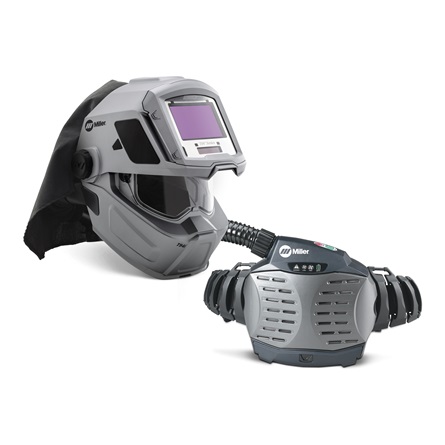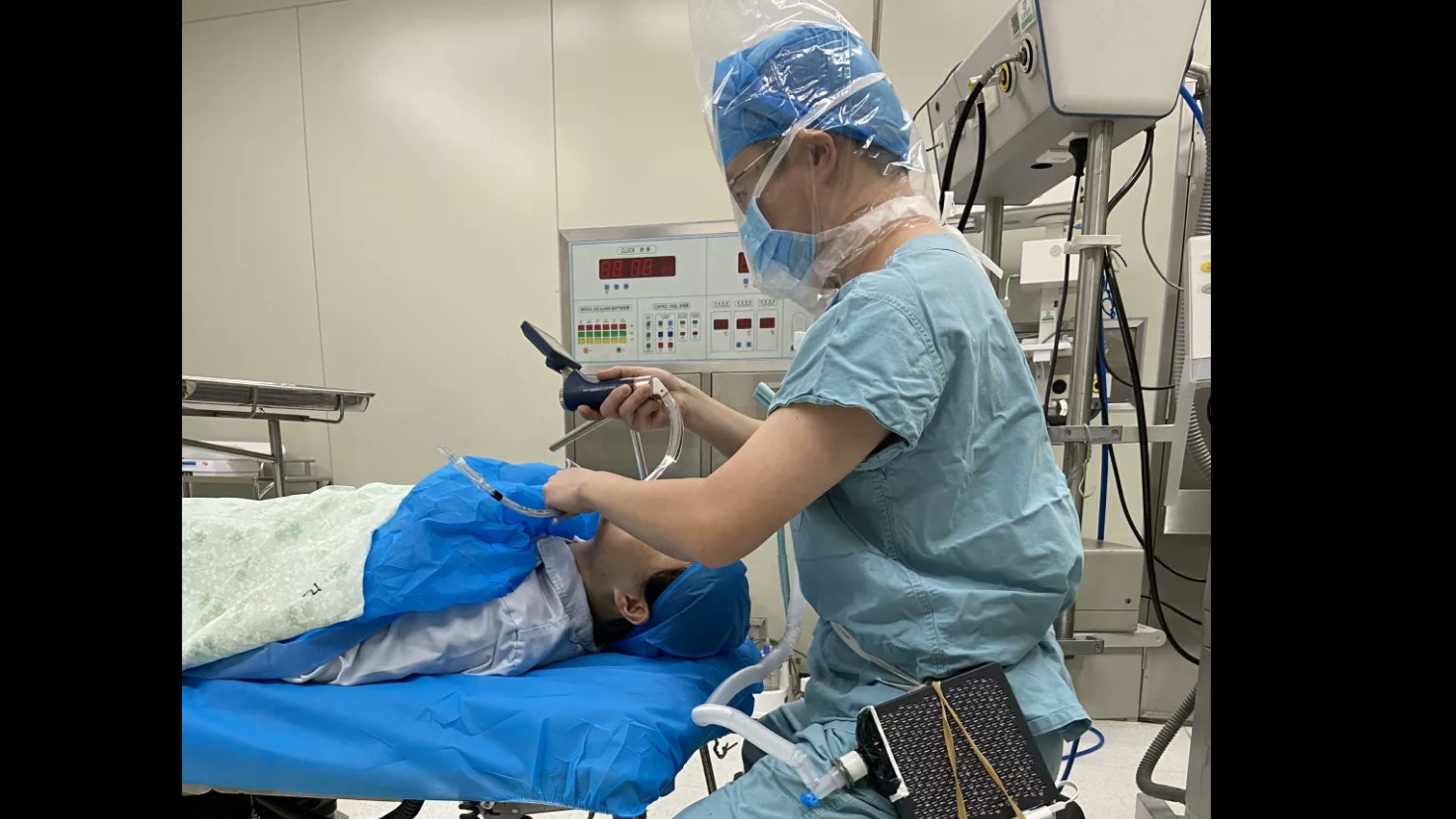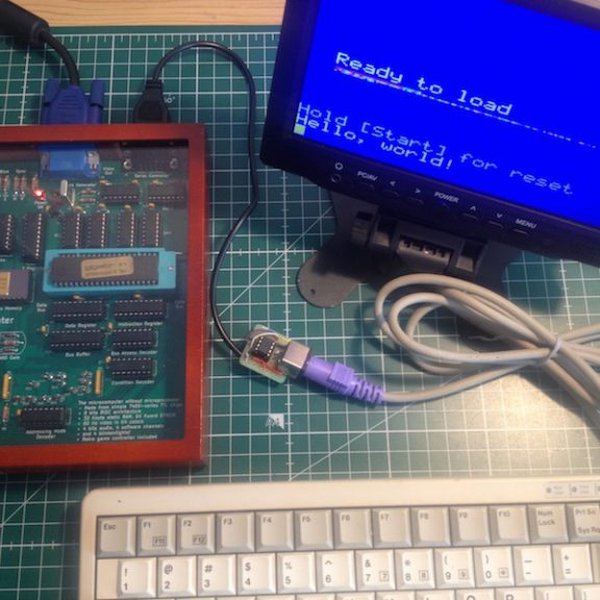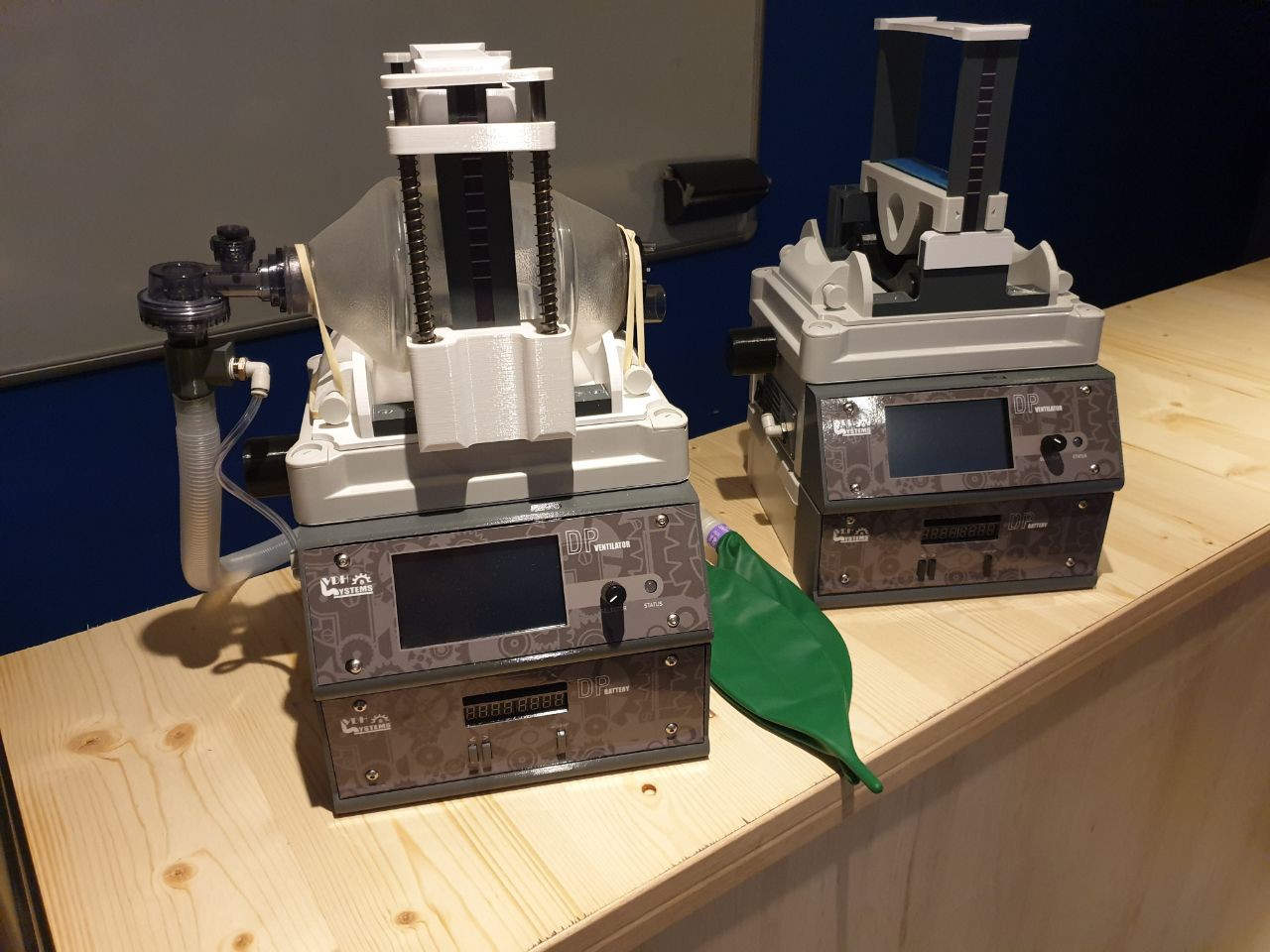-
Hack Chat Transcript, Part 2
06/17/2020 at 20:05 • 0 commentsMany people started 3D printing face shields (clear plastic protector with an FDM holder). I thought that was an amazing demonstration of distributed manufacturing of 3D printing being able to produce parts that were overwhelming commercial manufacturing sources
![]() More than logistics, the manufacturing capacity was not enough. This was pointed out by one of the last remaining face mask manufacturers in the USA
More than logistics, the manufacturing capacity was not enough. This was pointed out by one of the last remaining face mask manufacturers in the USA![]() Yeah I'm a very late adopter and this is one of several cases where that policy bit me in the butt
Yeah I'm a very late adopter and this is one of several cases where that policy bit me in the butt![]() Face shields help, especially if someone coughs directly to someone's face, but without an airtight seal, viral particles could theoretically get through
Face shields help, especially if someone coughs directly to someone's face, but without an airtight seal, viral particles could theoretically get through![]() @Hiram what's that you say? Globalized manufacturing supply chains can't physically meet demand fast enough for emergencies? This is my shocked face
@Hiram what's that you say? Globalized manufacturing supply chains can't physically meet demand fast enough for emergencies? This is my shocked face![]() Even a full face mask on someone with a beard will decrease the efficiency significantly. From all the testing it really makes you wonder what kind of protection, if any, most homemade N95 masks are providing. Probably very little
Even a full face mask on someone with a beard will decrease the efficiency significantly. From all the testing it really makes you wonder what kind of protection, if any, most homemade N95 masks are providing. Probably very little![]() Hiram, where does your mask exhaust? Through the N95 filters or through a separate port direct to the air?
Hiram, where does your mask exhaust? Through the N95 filters or through a separate port direct to the air?![]() The full face snorkel masks have an exhaust port on the front, in front of the mouth. They're unfiltered.
The full face snorkel masks have an exhaust port on the front, in front of the mouth. They're unfiltered.![]() The air resistance of the filters and lack of water pressure on the mouth exhaust mushroom valve will result in most of the air exiting through the mouth and a smaller fraction through the filters. If the mouth valve was sealed, then it would all go through the filters on top of the head where the snorkel attaches
The air resistance of the filters and lack of water pressure on the mouth exhaust mushroom valve will result in most of the air exiting through the mouth and a smaller fraction through the filters. If the mouth valve was sealed, then it would all go through the filters on top of the head where the snorkel attaches![]() Physicians in Miami we work with have been putting surgical masks over the mouth area. It looks like a robot with a face mask on.
Physicians in Miami we work with have been putting surgical masks over the mouth area. It looks like a robot with a face mask on.@William haha
![]() It's REALLY funny looking.
It's REALLY funny looking.![]() OK, I see it now. Yeah, I'd think moist breath going back through the filters would be a big problem
OK, I see it now. Yeah, I'd think moist breath going back through the filters would be a big problem![]() I think the COVID crisis has highlighted we need more local manufacturing of PPE so we are not vulnerable to global demand, supply chain, logistics, ...
I think the COVID crisis has highlighted we need more local manufacturing of PPE so we are not vulnerable to global demand, supply chain, logistics, ...![]() The mask looks like Shrek
The mask looks like Shrek![]() The photo of the face masks over the snorkel is here: https://www.protect-mi.org/reusable-face-shield
The photo of the face masks over the snorkel is here: https://www.protect-mi.org/reusable-face-shield![]() Yeah, and not just PPE. Lots of lessons to learn from all this
Yeah, and not just PPE. Lots of lessons to learn from all this+1
![]() It's not as funny head-on as with the side view. :D
It's not as funny head-on as with the side view. :D![]() I think one good thing about 3M filters is that there are many filter options that could do the job. Some have extra filtering features that are unnecessary. The ones we tested were mostly purely particulate filters
I think one good thing about 3M filters is that there are many filter options that could do the job. Some have extra filtering features that are unnecessary. The ones we tested were mostly purely particulate filters@Dan Maloney Agreed - I was blown away by the 3D printed face shields that many groups around the world were making, that's the first time I've seen distributed local manufacturing happen at that scale
![]() Anesthesia developed masks mainly focused on using commercial ventilator filters, some of which worked better than others
Anesthesia developed masks mainly focused on using commercial ventilator filters, some of which worked better than others![]() The 3D printed face shields have been amazing, but also pretty scary.
The 3D printed face shields have been amazing, but also pretty scary.![]() Did you ever toy with the idea of PPAR - powered air-purifying respirators?
Did you ever toy with the idea of PPAR - powered air-purifying respirators?![]()
https://www.millerwelds.com/safety/respiratory/powered-air-purifying-respirators-m00482
Powered Air Purifying Respirators (PAPR)
ClearLight™ Lens Technology Optimizes contrast and clarity in welding and light states, while providing a brighter light state to increase helmet-on time for non-welding tasks, enhancing visibility and reducing eye strain. Learn More
To follow up with Hiram, we also learned the limits of using different filter designs in a 3D printed design. I mentioned above that we gave up on using HEPA vacuum cleaner filters. We also found the Honeywell threaded filters weren't ideal for 3D printed adapters. Even with an SLA printer and trying several different resins we couldn't get the threading to seal well enough to pass the test. The 3M Bayonet design worked well in our hands.
![]() Little over the top, but you get the idea
Little over the top, but you get the idea![]() There's no quality control, and I have heard stories of them falling apart during use, which means someone ends up unprotected when they're already in a dangerous situation.
There's no quality control, and I have heard stories of them falling apart during use, which means someone ends up unprotected when they're already in a dangerous situation.![]() PAPR's are great, but they have a 115 to 170 liter per minute airflow, and typically weight 4.5 or so kg. They're upward of $1700 normally.
PAPR's are great, but they have a 115 to 170 liter per minute airflow, and typically weight 4.5 or so kg. They're upward of $1700 normally.![]() Ford + 3M have been making a $750 PAPR for this emergency (12,500 units/week, already NIOSH approved): https://www.cnet.com/roadshow/news/ford-respirator-healthcare-workers-coronavirus/
Ford + 3M have been making a $750 PAPR for this emergency (12,500 units/week, already NIOSH approved): https://www.cnet.com/roadshow/news/ford-respirator-healthcare-workers-coronavirus/@William yes agreed... I printed some for a group in St Louis that was collecting them for hospitals and had the same thought while taking them off my printer... is someone really going to use this???
![]() @Hiram Is O2sat actually a reliable signal to detect CO2 rebreathing? If there was mixing of exhalate with inhalate, couldn't hypercapnia be a problem even despite decent O2sat?
@Hiram Is O2sat actually a reliable signal to detect CO2 rebreathing? If there was mixing of exhalate with inhalate, couldn't hypercapnia be a problem even despite decent O2sat?![]() One local physician was developing a PAPR with some private money and drove to do the FDA testing. I think this was an idea they were hoping to commercialize. The first round of testing failed because the ventilator bacterial filter they used did not work. Not sure about the current status of the project. In theory it is probably easier to pass the test with a PAPR as air leaks become less of an issue
One local physician was developing a PAPR with some private money and drove to do the FDA testing. I think this was an idea they were hoping to commercialize. The first round of testing failed because the ventilator bacterial filter they used did not work. Not sure about the current status of the project. In theory it is probably easier to pass the test with a PAPR as air leaks become less of an issue![]()
https://hackaday.com/2020/02/12/hacked-protective-gear-keeps-doctor-safe-in-the-hot-zone/
Hacked Protective Gear Keeps Doctor Safe In The Hot Zone
It's rarely a wise idea to put a plastic bag over one's head, but when the choice is between that and possibly being exposed to a dangerous virus, you do what you have to. So you might as well do it right and build a field-expedient positive pressure hood.
![]() I don't think O2 sat is a good indicator of rebreathing. We measured CO2 directly in the eye chamber of the snorkel masks, and found nearly 0.5% CO2 when not using the Ocean Reef adaptor with the mushroom valve.
I don't think O2 sat is a good indicator of rebreathing. We measured CO2 directly in the eye chamber of the snorkel masks, and found nearly 0.5% CO2 when not using the Ocean Reef adaptor with the mushroom valve.![]() I would have to brush on my physiology. But @alexwhittemore you may be right. Arterial blood gases would be the way to test this on a subject or the Stanford group had a way to test this in their website
I would have to brush on my physiology. But @alexwhittemore you may be right. Arterial blood gases would be the way to test this on a subject or the Stanford group had a way to test this in their website![]() Our group has been developing a solution midway between a PAPR and a face shield.
Our group has been developing a solution midway between a PAPR and a face shield.![]() We're pursuing a new device class with FDA.
We're pursuing a new device class with FDA.![]() @Lex Kravitz HEPA vacuum cleaner filters. We were exactly here. Good to know. Thank you.
@Lex Kravitz HEPA vacuum cleaner filters. We were exactly here. Good to know. Thank you.![]() vacuum cleaner filters are a pretty bad solution for respiratory protection.
vacuum cleaner filters are a pretty bad solution for respiratory protection.![]() HEPA filters apparently can release carbon particles that can make the fit testing fail
HEPA filters apparently can release carbon particles that can make the fit testing fail![]() But they look good on paper...
But they look good on paper...![]() They need to handle very high loads of dirt and debris before failing, and back pressure is no issue.
They need to handle very high loads of dirt and debris before failing, and back pressure is no issue.@Daren Schwenke Yeah we liked that we could get them cheaply and easily, even at the height of the respirator filter shortages. It passed a qualitative test, but not the quantitative test. Some into on our experiences here: https://hackaday.io/project/170772-ocean-reef-snorkel-face-mask-emergency-ppe/log/176004-failed-attempt-to-adapt-a-hepa-vacuum-cleaner-filter
![]() You have a new follower. Thank you.
You have a new follower. Thank you.![]() They're really difficult to breathe through. NIOSH has limits on the pressure drop across filters for unpowered and powered respirators to avoid issues. Basically lungs can get hurt by pulling too hard.
They're really difficult to breathe through. NIOSH has limits on the pressure drop across filters for unpowered and powered respirators to avoid issues. Basically lungs can get hurt by pulling too hard.![]() We also looked at the HEPA air filtration solution it looks that you ended up with, but never generated the adapter.
We also looked at the HEPA air filtration solution it looks that you ended up with, but never generated the adapter.![]() So here we are at the top of the hour, and I'm sure Lex and Hiram both need to get back to work. I just want to say thanks to both of them for their time today, and that we really appreciate their efforts to respond to the pandemic in a productive way. Doctors, thank you both very much!
So here we are at the top of the hour, and I'm sure Lex and Hiram both need to get back to work. I just want to say thanks to both of them for their time today, and that we really appreciate their efforts to respond to the pandemic in a productive way. Doctors, thank you both very much!![]() ANother thing we learned is that some 3D prints may not be airtight and an airtight coating may be necessary. We also don't know how the VOCs from the different prints could affect someone's health
ANother thing we learned is that some 3D prints may not be airtight and an airtight coating may be necessary. We also don't know how the VOCs from the different prints could affect someone's health@Daren Schwenke I can share the 3D files if you want to try messing with them more
![]() 5 solid walls, overextrude.
5 solid walls, overextrude.![]() not pretty, but airtight.
not pretty, but airtight.![]() Thanks to everyone! Good luck with your projects
Thanks to everyone! Good luck with your projectsWe used a coating from Smooth-On which worked well to seal up PLA prints... not always pretty but it worked
Thanks all I have to get back to work as well!
![]() Thanks Lex! Thanks Hiram!
Thanks Lex! Thanks Hiram!![]() Lex and Kyle have been amazing collaborators!
Lex and Kyle have been amazing collaborators!![]() That's a good call. I think that the pneumask team insisted that only resin based prints would be acceptable, but I think that didn't make sense.
That's a good call. I think that the pneumask team insisted that only resin based prints would be acceptable, but I think that didn't make sense.![]() We were inherently lazy. :) Thank you @Lex Kravitz @Hiram . We can follow up offline if you want to share notes.
We were inherently lazy. :) Thank you @Lex Kravitz @Hiram . We can follow up offline if you want to share notes.![]() We're changing gears next week, with Walter from Gigatron:
We're changing gears next week, with Walter from Gigatron:![]()
https://hackaday.io/event/171602-gigatron-hack-chat
Gigatron Hack Chat
Walter Belgers will host the Hack Chat on Wednesday, June 24, 2020 at noon Pacific Time. Time zones got you down? Here's a handy time converter! In some ways, it's good that those days are gone.
![]() Thank you @Lex Kravitz & @Hiram!
Thank you @Lex Kravitz & @Hiram!![]() @william I think a simple solution would be a food grade silicon coating
@william I think a simple solution would be a food grade silicon coating![]() I'll be posting a transcript shortly. Thanks all!
I'll be posting a transcript shortly. Thanks all! -
Hack Chat Transcript, Part 1
06/17/2020 at 20:05 • 0 commentsHi!
Thanks for setting this up!
![]() You bet. Thanks for suggesting it, and for your time today.
You bet. Thanks for suggesting it, and for your time today.You're welcome! I hope Hiram shows up, he's the one who actually knows about the testing procedures :)
![]() Hi Lex, Hiram, did you get the email I sent to Dan?
Hi Lex, Hiram, did you get the email I sent to Dan?Yup, thanks for forwarding that info I think we'll start the chat with a discussion of that, and how these emergency adaptations are not FDA approved
![]() I have been working with Ocean Reef Group, and using their APA adaptor for the Aria snorkel mask that you're showing here.
I have been working with Ocean Reef Group, and using their APA adaptor for the Aria snorkel mask that you're showing here.Cool! Do you work in healthcare? Or medical devices?
![]() I develop scientific equipment, I'm a PhD analytical chemist.
I develop scientific equipment, I'm a PhD analytical chemist.![]() I have translated spectroscopy equipment to medical applications, and done in vivo human research at the University of Michigan Hospitals and at the VA.
I have translated spectroscopy equipment to medical applications, and done in vivo human research at the University of Michigan Hospitals and at the VA.Cool I'm a neuroscientist but do a lot of 3D design and electronics work for our neuro experiments, and got in touch with Hiram back in March when he was looking for some help making scuba adapters for use in his radiology practice when they couldn't obtain adequate PPE due to shortages
![]() Our group in Michigan tested out a couple of adaptors equivalent to the Pneumask and MasksOn.org adaptors (simple mechanical adaptors from the snorkel mask to inline viral filters), and we found significant increases in CO2 in the inlet airspace compared to what we got when we used the mushroom-valve adaptor from Ocean Reef, so we discontinued our development project on the snorkel mask adaptors.
Our group in Michigan tested out a couple of adaptors equivalent to the Pneumask and MasksOn.org adaptors (simple mechanical adaptors from the snorkel mask to inline viral filters), and we found significant increases in CO2 in the inlet airspace compared to what we got when we used the mushroom-valve adaptor from Ocean Reef, so we discontinued our development project on the snorkel mask adaptors.![]() Have you guys tried the Ocean Reef APA adaptor in any of your testing? They have EN (european certifications) on their respirator solution, but haven't gotten the US CDC/NIOSH approvals for use in healthcare settings yet.
Have you guys tried the Ocean Reef APA adaptor in any of your testing? They have EN (european certifications) on their respirator solution, but haven't gotten the US CDC/NIOSH approvals for use in healthcare settings yet.https://oceanreefgroup.com/covid19/
Hiram did all of the testing, I'm not sure if he got the Ocean Reef adapter but he should be on the chat soon!
![]() The most complicated piece of this PPE is how so many people got feedback from FDA (CDRH) that the snorkel mask qualified as a face shield. But the snorkel masks are being used with air filters, which means they're respirators, and don't qualify under the FDA EUA as face shields, and instead need CDC NIOSH approvals.
The most complicated piece of this PPE is how so many people got feedback from FDA (CDRH) that the snorkel mask qualified as a face shield. But the snorkel masks are being used with air filters, which means they're respirators, and don't qualify under the FDA EUA as face shields, and instead need CDC NIOSH approvals.Hi Hiram!
![]() Hello, is this audio or just text
Hello, is this audio or just text![]() OK, looks like both Hiram and Lex are here, so let's get started. Welcome everyone, I'm Dan and I'll be moderating today. We have Lex Kravitz and Hiram Gay today to talk about testing for an emergency PPE they made.
OK, looks like both Hiram and Lex are here, so let's get started. Welcome everyone, I'm Dan and I'll be moderating today. We have Lex Kravitz and Hiram Gay today to talk about testing for an emergency PPE they made.![]() Just text, Hiram.
Just text, Hiram.![]() Only if you play Wargames.
Only if you play Wargames.![]() OK
OK![]() *crickets*
*crickets*![]() Can we start out with a little about yourselves, Hiram and Lex?
Can we start out with a little about yourselves, Hiram and Lex?![]() @Daren Schwenke - Excellent classical reference
@Daren Schwenke - Excellent classical referenceHi all! To give a quick introduction I am a neuroscientist at Washington University in St Louis, and I do a lot of 3D printing and electronics related to our neuroscience experiments. I was contacted by Dr. Hiram Gay in March to help with adapting scuba masks to be used as personal protective equipment PPE in his radiology clinic.
![]() My name is Hiram Gay, I am a radiation oncologist at WashU in St. Louis. Specialize in head and neck and prostate cancer
My name is Hiram Gay, I am a radiation oncologist at WashU in St. Louis. Specialize in head and neck and prostate cancerI can talk about the 3D design and some of out experiences there, Hiram can talk about the testing that we performed, and what it takes to test improvised solutions
![]() One of the satellite offices I direct treat between 20-50 patients a day. Each treatment course is from 1-44 days. Our therapists have a lot of patient exposure and can not social distance. This was the motivation for the snorkel project.
One of the satellite offices I direct treat between 20-50 patients a day. Each treatment course is from 1-44 days. Our therapists have a lot of patient exposure and can not social distance. This was the motivation for the snorkel project.We also did want to talk briefly about the issue of FDA approval - this is critical if a design is being distributed or sold for medical use. It is less of an issue for personal use, or in an emergency use situation in a medical clinic if FDA approved PPE isn't available, as happened in many facilities earlier this year
There are many people working on adapting scuba masks for PPE. This project: https://www.pneumask.org/ has some good info on their experience with FDA approvals: https://www.pneumask.org/fda-status
![]() It makes sense when you think about it - physicians have always been able to use instruments of their own design to treat patients, right?
It makes sense when you think about it - physicians have always been able to use instruments of their own design to treat patients, right?![]() The Pneumask info is not up to date. FDA has clarified the position on the snorkel masks as being full face respirators.
The Pneumask info is not up to date. FDA has clarified the position on the snorkel masks as being full face respirators.The snorkel masks are not approved for use in healthcare settings by the FDA, because they don't qualify under the FDA EUA for face shields, or the FDA EUA for respirators (which only cover NIOSH-approved respirators).
![]() EUA?
EUA?![]() EUA is emergency use authorization.
EUA is emergency use authorization.https://www.fda.gov/medical-devices/emergency-situations-medical-devices/faqs-euas-non-niosh-approved-respirators-during-covid-19-pandemic
![]() Gotcha, thanks
Gotcha, thanksHiram do you want to comment on this? How does this work in your clinic, especially if FDA-approved respirators aren't available?
![]() Yes, especially in the surgical fields. Radiation Oncology is a more hands off type of specialty, so except in the area of brachytherapy (radioactive sources), we usually don't come up with devices. If you see, most of the snorkel mask ideas were born in anesthesia departments since this is a more natural transition
Yes, especially in the surgical fields. Radiation Oncology is a more hands off type of specialty, so except in the area of brachytherapy (radioactive sources), we usually don't come up with devices. If you see, most of the snorkel mask ideas were born in anesthesia departments since this is a more natural transition![]() Sorry- here's the link to the FDA COVID-19 EUA's for PPE:
Sorry- here's the link to the FDA COVID-19 EUA's for PPE:https://www.fda.gov/medical-devices/coronavirus-disease-2019-covid-19-emergency-use-authorizations-medical-devices/personal-protective-equipment-euas
![]() In the beginning there was a a big PPE shortage. Now it has eased. I think the snorkel mask idea solved the need for a face shield and a filtration system. At our hospital eventually we were allowed to bring any home PPE, and this allowed us to deploy the snorkel mask
In the beginning there was a a big PPE shortage. Now it has eased. I think the snorkel mask idea solved the need for a face shield and a filtration system. At our hospital eventually we were allowed to bring any home PPE, and this allowed us to deploy the snorkel mask![]() FDA approval takes a lot of time. My understanding is it takes about $600 per device, and you may be required to test 10, so the costs add up if there is no private or corporation sponsorship
FDA approval takes a lot of time. My understanding is it takes about $600 per device, and you may be required to test 10, so the costs add up if there is no private or corporation sponsorship![]() Respirator approval goes through CDC's NIOSH group. The manufacturer needs to be approved, and the specific respirator combinations (mask + filters) need to be approved. It's several thousand dollars in fees, and requires the manufacturer of the device to be approved and meed good manufacturing practice (GMP) standards.
Respirator approval goes through CDC's NIOSH group. The manufacturer needs to be approved, and the specific respirator combinations (mask + filters) need to be approved. It's several thousand dollars in fees, and requires the manufacturer of the device to be approved and meed good manufacturing practice (GMP) standards.![]() Full face snorkel masks require a fit factor of 500, while half-face masks including N95 masks require a fit factor of 100. It is very challenging to meet these requirements. the fit factor formula is: the ratio of the average chamber concentration to the concentration measured inside the respirator
Full face snorkel masks require a fit factor of 500, while half-face masks including N95 masks require a fit factor of 100. It is very challenging to meet these requirements. the fit factor formula is: the ratio of the average chamber concentration to the concentration measured inside the respirator![]() They perform testing of 3 masks and 10 filters. The testing is performance testing with the respirator sealed to a test fixture that then measures how much particulate passes through the device.
They perform testing of 3 masks and 10 filters. The testing is performance testing with the respirator sealed to a test fixture that then measures how much particulate passes through the device.![]() Concentration of what? Is there a tracer particle of some sort?
Concentration of what? Is there a tracer particle of some sort?![]()
https://www.cdc.gov/niosh/npptl/stps/apresp.html
Current Standard Testing Procedures for Air-Purifying Respirators | NPPTL | NIOSH | CDC
NPPTL Standard Respirator Testing Procedures, Air-Purifying Respirators
We posted info on our testing procedures and equipment here: https://hackaday.io/project/170772-ocean-reef-snorkel-face-mask-emergency-ppe/log/176101-methods-and-results
![]() The key to success is having a qualified filter, in our case we used commercial 3M filters, and an airtight system (good seal around the face and putty to seal the 3D printed adapter Lex created
The key to success is having a qualified filter, in our case we used commercial 3M filters, and an airtight system (good seal around the face and putty to seal the 3D printed adapter Lex created![]()
![]()
![]() I know it's hard to get it medical proved, I made a respirator and still in process to get it on track
I know it's hard to get it medical proved, I made a respirator and still in process to get it on track![]() You can do the test with the normal air particles in the air, but if the concentration is to low the PortaCount machine will let you know. With the machine you can get a particle generator which basically aerosolizes salt particles
You can do the test with the normal air particles in the air, but if the concentration is to low the PortaCount machine will let you know. With the machine you can get a particle generator which basically aerosolizes salt particles![]() OK, cool - thought it might have been a smoke generator or something.
OK, cool - thought it might have been a smoke generator or something.Early on we tried some HEPA filters from vacuum cleaners - we tried them out because they were easy to obtain when most other respirator filters were out of stock. However these did not work!
![]() I made it open source #DP Ventilator
I made it open source #DP Ventilator![]() Hi everyone! Sorry if this has already been asked, how many people have used the snorkel design?
Hi everyone! Sorry if this has already been asked, how many people have used the snorkel design?![]() There is a qualitative (not quantitative test) that uses a pungent smoke, but it is still less rigorous than the PortaCount
There is a qualitative (not quantitative test) that uses a pungent smoke, but it is still less rigorous than the PortaCount![]() I'm really curious to hear more about on-person testing and how you were able to iterate the 3D printed parts
I'm really curious to hear more about on-person testing and how you were able to iterate the 3D printed partsIs the test using a "standard head" or a live person?
![]() https://maskson.org/ have distributed almost 18000.
https://maskson.org/ have distributed almost 18000.https://www.pneumask.org/ have distributed another 23500.
![]() The one we designed is used by our therapists when we treat a patient suspected of COVID. SO far have not treated a COVID patient. We have 6 therapists, Other snorkel masks have been used across the country. The Pneumask project from Stanford was the most ambitious and rigorous
The one we designed is used by our therapists when we treat a patient suspected of COVID. SO far have not treated a COVID patient. We have 6 therapists, Other snorkel masks have been used across the country. The Pneumask project from Stanford was the most ambitious and rigorous![]() So how is the situation right now with filters? How quickly are orders being filled?
So how is the situation right now with filters? How quickly are orders being filled?![]() Testing is with a real person
Testing is with a real person![]() How does testing work?
How does testing work?![]() Does the person pretend like they have a breathing issue?
Does the person pretend like they have a breathing issue?I believe for healthcare facilities the filter supply has gotten much better. In March/April we couldn't buy respirator filters anywhere (except for marked up prices on eBay). One thing the manufacturers (mainly 3M and Honeywell) started doing was limiting private sales and prioritizing healthcare sale.
![]() I spent hours with the PortaCount and testing designs Lex created on myself. At first it was very frustrating because I could not get fit factors reliably above 100. Once we used the 3M filters and sealed the connection with the adapter, we got close to a commercial 3M mask
I spent hours with the PortaCount and testing designs Lex created on myself. At first it was very frustrating because I could not get fit factors reliably above 100. Once we used the 3M filters and sealed the connection with the adapter, we got close to a commercial 3M mask![]() So, what is a reasonable expected timeframe between ordering and shipping?
So, what is a reasonable expected timeframe between ordering and shipping?@Joseph Stavitsky I haven't purchased respirator filters, but in my lab we are able to order other forms of PPE (gloves, masks) normally at this point. Like ~1 week including shipping. We order through healthcare channels though.
![]() The testing is standardized and lasts about 7 and a half minutes. I believe a shorter version of the test has been approved
The testing is standardized and lasts about 7 and a half minutes. I believe a shorter version of the test has been approved![]() Some filters have continued to be readily available throughout the crisis, such as the 22mm inline bacterial/viral filters.
Some filters have continued to be readily available throughout the crisis, such as the 22mm inline bacterial/viral filters.https://teleflex.com/usa/en/product-areas/respiratory/passive-humidification-and-filtration/bacterial-viral-filters/index.html
@Sophi Kravitz Hiram put info on the testing setup here: https://hackaday.io/project/170772-ocean-reef-snorkel-face-mask-emergency-ppe/log/176101-methods-and-results The person simulates several types of breathing and positions during the test
![]() Normal breathing
Normal breathingDeep breathing
Head side to side
Head up and down
Talking
Bending over
Normal breathing
Overall fit factor
![]() Above are the parts of the testing, missing is grimace
Above are the parts of the testing, missing is grimace![]() hahaha
hahaha![]() I suppose if you're having trouble breathing, grimace is going to happen
I suppose if you're having trouble breathing, grimace is going to happen![]() grimace is inevitable
grimace is inevitable![]() Head up and down, bending over and talking are usually the weaker links that may result in failing the test
Head up and down, bending over and talking are usually the weaker links that may result in failing the test![]() :)
:)![]() I currently have retail access to rubber gloves. I am planning a nonprofit to make masks and faceshields. Would it be possible for any of you to reach out to your medical contacts and get back to me with order wait times?
I currently have retail access to rubber gloves. I am planning a nonprofit to make masks and faceshields. Would it be possible for any of you to reach out to your medical contacts and get back to me with order wait times?![]() How does the face shield perform in terms of fogging? Every time I wear a mask or a respirator it fogs up my glasses something fierce. I'd imagine breathing onto the surface of the face shield would do the same.
How does the face shield perform in terms of fogging? Every time I wear a mask or a respirator it fogs up my glasses something fierce. I'd imagine breathing onto the surface of the face shield would do the same.![]() https://www.globalindustrial.com/ can be a good source for filters and PPE
https://www.globalindustrial.com/ can be a good source for filters and PPE![]() And following up on Dan's point, is there a demonstrated benefit to covering the eyes?
And following up on Dan's point, is there a demonstrated benefit to covering the eyes?![]() Our nonprofit has been working on PPE (including getting regulatory approval) for the past 3 months. It's been a long grind.
Our nonprofit has been working on PPE (including getting regulatory approval) for the past 3 months. It's been a long grind.@Hiram related to Dan's question - were people in your clinic able to wear the scuba mask for long durations?
![]() Yes, there has been a lot of research indicating a benefit to providing physical barrier protection like face shields or goggles, as well as respiratory protection against aerosols.
Yes, there has been a lot of research indicating a benefit to providing physical barrier protection like face shields or goggles, as well as respiratory protection against aerosols.![]() @Hiram thanks for the link. Is there a specific model I should look at?
@Hiram thanks for the link. Is there a specific model I should look at?![]() The design of the OceanReef masks minimizes fogging. The air flows in such a way that it exits through a mouth valve or the filters. The mouth valve open won't protect patients if the user has COVID. The mouth valve can be sealed, but the mask is less comfortable and the humidity content will increase. Still you can see
The design of the OceanReef masks minimizes fogging. The air flows in such a way that it exits through a mouth valve or the filters. The mouth valve open won't protect patients if the user has COVID. The mouth valve can be sealed, but the mask is less comfortable and the humidity content will increase. Still you can see@William Thanks for your work with www.protect-mi.org!
![]() And I'd imagine there are a lot of things that radiation oncology techs handle that really don't belong in their eyes
And I'd imagine there are a lot of things that radiation oncology techs handle that really don't belong in their eyes![]() @william could you please point at some links for eye protection?
@william could you please point at some links for eye protection?![]() The preprints of the project lists various filters https://www.preprints.org/manuscript/202004.0293/v2
The preprints of the project lists various filters https://www.preprints.org/manuscript/202004.0293/v2![]() In the coming week there should be a 3rd version of the manuscript and we will be submitting to a peer reviewed journal soon
In the coming week there should be a 3rd version of the manuscript and we will be submitting to a peer reviewed journal soon![]() If you have access to a legit 3M full face mask, that is the way to go. It works very efficiently since the filters connect directly to the mouth compartment
If you have access to a legit 3M full face mask, that is the way to go. It works very efficiently since the filters connect directly to the mouth compartment![]() Eye protection could be anything from swim goggles, ski goggles, or as fancy as a full faced mask. There are many options out there
Eye protection could be anything from swim goggles, ski goggles, or as fancy as a full faced mask. There are many options out there![]() https://www.globalindustrial.com/searchResult?q=3m+full+faced+mask some masks
https://www.globalindustrial.com/searchResult?q=3m+full+faced+mask some masksYes I think that's a big take-home here: these improvised solutions can be useful when the supply of commercial respirators isn't there, but if you can get a real respirator it will likely function better than anything improvised.
![]() One of our collaborators has a company that specializes in snorkeling and scuba equipment. They have many goggles and snorkel masks (with adaptors) in stock: https://www.isnorkel.com/masks-goggles/
One of our collaborators has a company that specializes in snorkeling and scuba equipment. They have many goggles and snorkel masks (with adaptors) in stock: https://www.isnorkel.com/masks-goggles/![]() https://www.uline.com/ this is another good website for PPE and filters
https://www.uline.com/ this is another good website for PPE and filters![]() I was just looking at the offerings that Ocean Reef has. Snorkeling has changed a LOT since I was doing it back in the 80s
I was just looking at the offerings that Ocean Reef has. Snorkeling has changed a LOT since I was doing it back in the 80shaha @Dan Maloney I had that same thought when I saw the Ocean Reef site!
![]() CO2 rebreathing is a problem with some snorkel mask designs. Ocean reef minimizes this. We tested O2 saturation to verify this was not being compromised. Stanford did the tests in a more sophisticated way
CO2 rebreathing is a problem with some snorkel mask designs. Ocean reef minimizes this. We tested O2 saturation to verify this was not being compromised. Stanford did the tests in a more sophisticated way![]() I mean, I get that commercial manufacturers are always going to be better but doesn't the current situation show that we need a logistics infrastructure in place when they can't meet demand?
I mean, I get that commercial manufacturers are always going to be better but doesn't the current situation show that we need a logistics infrastructure in place when they can't meet demand?@Joseph Stavitsky Yes I think so!
About Us Contact Hackaday.io Give Feedback Terms of Use Privacy Policy Hackaday API
 Lutetium
Lutetium

 Hiram, where does your mask exhaust? Through the N95 filters or through a separate port direct to the air?
Hiram, where does your mask exhaust? Through the N95 filters or through a separate port direct to the air?









